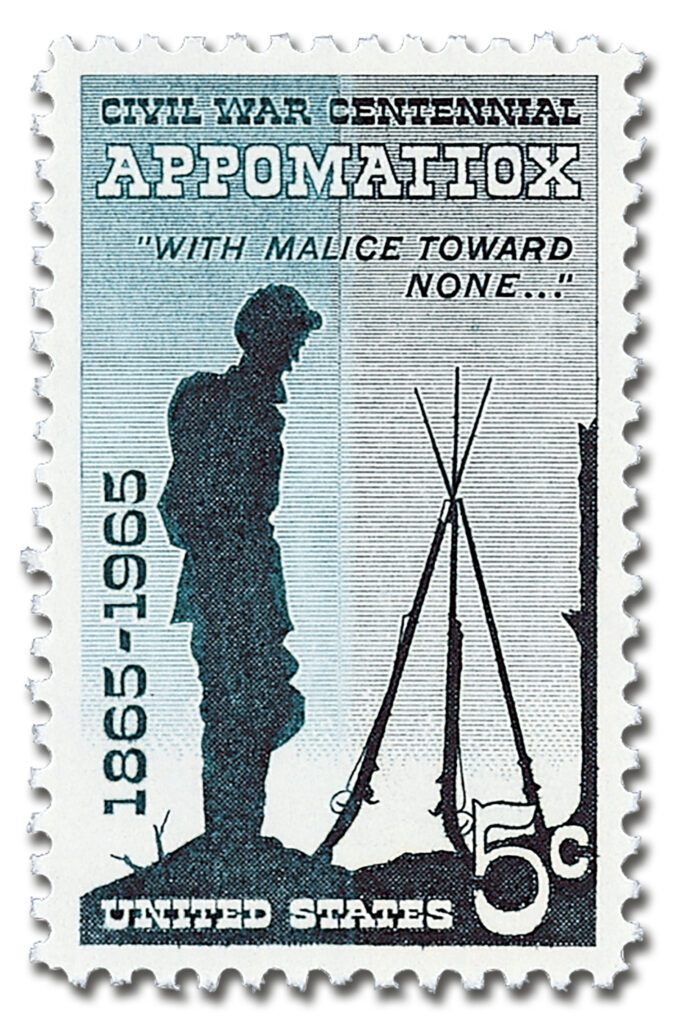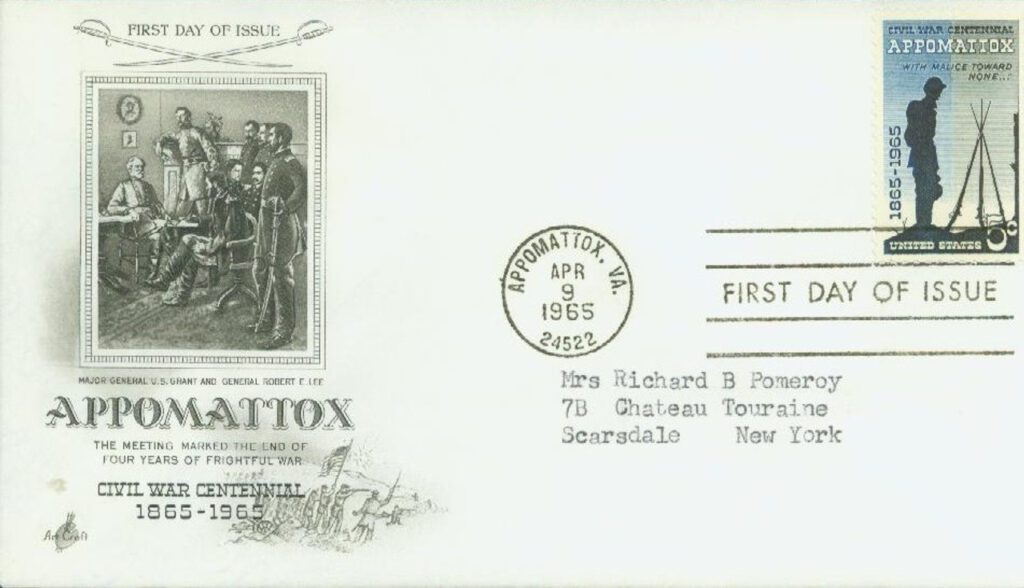On April 9, 1865, Robert E. Lee surrendered his Army of Northern Virginia to Ulysses S. Grant, effectively ending the Civil War.
Following the 10-month siege of Petersburg and defeat at Five Forks, Southern General Robert E. Lee hoped to meet up with the Army of Tennessee and go on the offensive near the Roanoke River bordering Virginia and North Carolina. He planned to reform his forces, made up of two small infantry corps and a cavalry corps, at Amelia Courthouse where he anticipated supplies would be waiting.
When Lee arrived, he was disappointed to find no provisions had made it there. The commander sent his supply wagons to forage in the surrounding areas, but local farmers had little food to spare. Having lost a day of marching, the Confederates set off that evening for Appomattox Station to meet their supply train.
During the march, Philip Sheridan’s cavalry and two infantry corps cut off almost one fourth of the Confederate army at Sailor’s Creek (also spelled Sayler’s Creek). To add to Lee’s difficulties, Sheridan reached Appomattox Station before the dwindling Confederate forces and captured the supplies.
The next day, April 7, Grant sent a message to Lee requesting him to surrender. Lee refused, but asked for the conditions anyway. The following day brought more disappointment for the Confederates. Three supply trains were burned at Appomattox Station as the Union’s Army of the Potomac and the Army of the James were both closing in on the Southerners. Lee’s last hope for supplies lay in Lynchburg, but Union cavalry was positioned between his army and their goal. He hoped to break through before Grant sent reinforcements to Sheridan’s units at Appomattox Court House.
At dawn on April 9, the Confederates’ Second Corps began their attack on Sheridan’s cavalry unit guarding the stage road. After initial success, they were overwhelmed. General Gordon, commander of the corps, reported to Lee his men had “been fought to a frazzle” and asked for reinforcements. There were none available. Realizing the hopelessness of the situation, Lee told his aides, “There is nothing left for me to do but to go and see General Grant, and I would rather die a thousand deaths.” Lee sent a message to Grant requesting to meet him.
The Union commander was heading toward the front when he received the note from Lee shortly before noon. In his reply, Grant told Lee to choose a spot where the two could meet. Lee sent some of his aides to the small village of Appomattox Court House to search for a suitable location. The men asked local resident Wilmer McLean for advice. He recommended an empty building, but there was no furniture inside. He then offered his own home. The aides accepted and returned to Lee with news of the location.
Lee arrived at the McLean house in a clean dress uniform at 1:00 p.m. Grant came a half-hour later in his well-worn field uniform and mud-splattered boots. The two had met many years before during the Mexican-American War. They discussed their previous meeting for a while, before Lee brought the discussion back to the present. Lee asked for the terms of surrender and Grant replied they would remain as stated in a letter he had sent to the Confederate commander only days earlier.
The Confederate troops were allowed to return home, but could never take up arms against the United States again. All arms and artillery were turned over to the Union, except officers’ sidearms. Lee asked if his men could keep their horses or mules, because they would be needed for farming. Grant agreed to the request. When the Southern general mentioned his men had not eaten in days, Grant arranged for 25,000 rations to be sent to the defeated army.
The arrangements were completed by about 4:00 p.m. As Lee rode away, some of the Union troops began to cheer. Grant silenced them saying, “The Confederates were now our countrymen, and we did not want to exult over their downfall.” Later that day, Lee and Grant sat on McLean’s porch and met with generals from both sides. The respect both men showed toward each other led the surrender to be called “The Gentlemen’s Agreement.”
Though Lee had surrendered the Army of Northern Virginia, there were still about 175,000 Confederates on other battlefields. But their strongest commander had fallen, and the men were low on food and other supplies. It was just a matter of time before the rest of the Southern army surrendered.

On April 26, General Johnston’s troops laid down their arms in North Carolina. The Trans-Mississippi Department gave up their fight for New Orleans the following month. Nathan Forrest, read his farewell address to his troops in Alabama on May 9. The Confederate flag was lowered for the last time onboard the CSS Shenandoah on November 6, 1865. Captain James Waddell had sailed to Liverpool, England, to avoid being tried in the US as a pirate.
The Civil War was now over. It would take years to repair the damage the conflict inflicted. The respect Generals Grant and Lee showed each other at Appomattox Court House set a fine example for soldiers from both sides to follow.
Click here for more Civil War stamps.
Click here to read the text of the surrender document and Lee’s farewell address.
| FREE printable This Day in History album pages Download a PDF of today’s article. Get a binder or other supplies to create your This Day in History album. |
Discover what else happened on This Day in History.







Its not a story but history. It really happened. Respect given to defeated general shows Grant’s maturity of mind. They are our people supersedes over victory.
Stamps bring the happenings to light the events took place before our life time. Our generation knows desert storm, Nine eleven etc. but other events that took place on this soil of ours is known from reading, watching movies etc. Let there be peace everywhere.
This is a noble nation, not perfect, but just in its cause for freedom. We should never be ashamed of our history, it should never be erased, thus how shall we learn and move on. These noble men on both sides, fought side by side, in battles before, and we have learned to reunite for this cause of freedom. This great nation, is that way, because of our history. It is one of the few nations that people are dying to get in, except for the few that left to keep from dying for that cause of freedom. Neither side was perfect, in this war, but we are a stronger nation for it and must remain united for the greater cause, the cause of freedom. God help us never to abuse it.
McLean, the owner of the home , had moved to get away from the war after the battle of Bull Run had dameged his home early in the war. Now the war ended in his front yard.
Well addressed
Nice to learn somthing i had missed.
I really enjoy “This day in history.” I hope Mystic Stamps offers a collection album and stamps soon. It would be a great collection.
This is a nice description of the last few days of Lee’s army, if a bit on the sentimental side. The last sentence about Lee and Grant showing respect for each other and this setting a fine example for both sides is a little hard to swallow in view of the events of the next few years and indeed, the next century. Within months of Appomattox, southern state legislatures began to pass “black codes” which had the effect of nearly re-enslaving the newly freed slaves. The Ku Klux Klan and other white supremacist organizations were founded and used intimidation and terror to suppress African Americans who were supposed to have rights under the 14th and 15th Amendments. By the 20th century, Jim Crow segregation was the rule throughout the South and in some parts of the North. It has been said that although the North won the Civil War, the South won the peace, at least politically and socially.
Excellent and very emotionally moving recount of “This Day in history”. So nice that I have another chance to learn so much of what I did not take advantage of when I was a kid.
Nice to read the surrender document and Lee’s farewell address. Rarely seen.
Interesting post; thank you to Mystic’s TDIH to learn a little history of our country. Now I can give my stamps a second look with more knowledge as to their significance. And a special thank you for the additional links, as well as those who took the time and effort to post and add to the discussion. A true philatelic community.